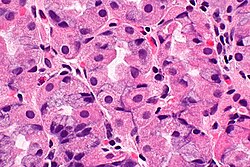Difference between revisions of "Proton pump inhibitor effect"
Jump to navigation
Jump to search

m (→Microscopic: tweak) |
|||
| (One intermediate revision by one other user not shown) | |||
| Line 33: | Line 33: | ||
==Microscopic== | ==Microscopic== | ||
Features:<ref>{{Cite journal | last1 = Driman | first1 = DK. | last2 = Wright | first2 = C. | last3 = Tougas | first3 = G. | last4 = Riddell | first4 = RH. | title = Omeprazole produces parietal cell hypertrophy and hyperplasia in humans. | journal = Dig Dis Sci | volume = 41 | issue = 10 | pages = 2039-47 | month = Oct | year = 1996 | doi = | PMID = 8888719 }}</ref> | Features:<ref name=pmid8888719>{{Cite journal | last1 = Driman | first1 = DK. | last2 = Wright | first2 = C. | last3 = Tougas | first3 = G. | last4 = Riddell | first4 = RH. | title = Omeprazole produces parietal cell hypertrophy and hyperplasia in humans. | journal = Dig Dis Sci | volume = 41 | issue = 10 | pages = 2039-47 | month = Oct | year = 1996 | doi = | PMID = 8888719 }}</ref><ref>{{Pathologyoutlines| topic/stomachPPI}}</ref> | ||
*Parietal cell enlargement - '''key feature'''. | *Parietal cell enlargement - '''key feature'''. | ||
**Parietal cells typically bulge into the lumen. | **Parietal cells typically bulge into the lumen. | ||
*G cell and enterochromaffin cell-like hyperplasia. | |||
**Compensatory change due to increased pH in gastric lumen. | |||
*Multiple fundic gland polyps (with PPI use over several months). | |||
**Polyps may regress after PPI is stopped. | |||
===Images=== | ===Images=== | ||
Latest revision as of 18:36, 2 March 2020
Proton pump inhibitor effect, abbreviated PPI effect, is a change seen in the parietal cells of the stomach due to a drug in the proton pump inhibitor class.

Stomach with PPI effect. H&E stain.
Formally, it is stomach with proton pump inhibitor effect.
General
- Due to intake of a proton pump inhibitor (PPI).
- Used to treat gastroesophageal reflux disease.
Some proton pump inhibitors
| Generic name | Brand name(s) |
|---|---|
| Omeprazole | LOSEC |
| Dexlansoprazole | DEXILANT |
| Lansoprazole | PREVACID |
| Esomeprazole | NEXIUM |
| Pantoprazole | PANTOLOC |
| Rabeprazole | PARIET |
Microscopic
- Parietal cell enlargement - key feature.
- Parietal cells typically bulge into the lumen.
- G cell and enterochromaffin cell-like hyperplasia.
- Compensatory change due to increased pH in gastric lumen.
- Multiple fundic gland polyps (with PPI use over several months).
- Polyps may regress after PPI is stopped.
Images
www:
Sign out
- Usually not reported.
See also
References
- ↑ Driman, DK.; Wright, C.; Tougas, G.; Riddell, RH. (Oct 1996). "Omeprazole produces parietal cell hypertrophy and hyperplasia in humans.". Dig Dis Sci 41 (10): 2039-47. PMID 8888719.
- ↑ topic/stomachPPI.html topic/stomachPPI